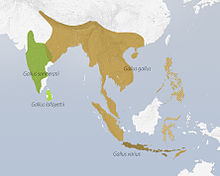
Poultry are domesticated birds kept by humans for the purpose of harvesting animal products such as meat, eggs or feathers. The practice of raising poultry is known as poultry farming. These birds are most typically members of the superorder Galloanserae (fowl), especially the order Galliformes. The term also includes waterfowls of the family Anatidae but does not include wild birds hunted for food known as game or quarry.

The chicken is a large and round short-winged bird, domesticated from the red junglefowl of Southeast Asia around 8,000 years ago. Most chickens are raised for food, providing meat and eggs; others are kept as pets or for cockfighting.

The common pheasant is a bird in the pheasant family (Phasianidae). The genus name comes from Latin phasianus, "pheasant". The species name colchicus is Latin for "of Colchis", a country on the Black Sea where pheasants became known to Europeans. Although Phasianus was previously thought to be closely related to the genus Gallus, the genus of junglefowl and domesticated chickens, recent studies show that they are in different subfamilies, having diverged over 20 million years ago.
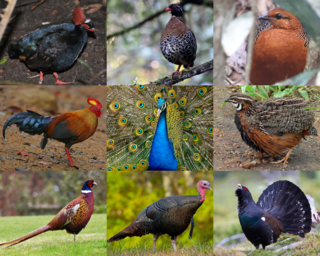
The Phasianidae are a family of heavy, ground-living birds, which includes pheasants, partridges, junglefowl, chickens, turkeys, Old World quail, and peafowl. The family includes many of the most popular gamebirds. The family is a large one and includes 185 species divided into 54 genera. It was formerly broken up into two subfamilies, the Phasianinae and the Perdicinae. However, this treatment is now known to be paraphyletic and polyphyletic, respectively, and more recent evidence supports breaking it up into two subfamilies: Rollulinae and Phasianinae, with the latter containing multiple tribes within two clades. The New World quail (Odontophoridae) and guineafowl (Numididae) were formerly sometimes included in this family, but are now typically placed in families of their own; conversely, grouse and turkeys, formerly often treated as distinct families, are now known to be deeply nested within Phasianidae, so they are now included in the present family.

Junglefowl are the only four living species of bird from the genus Gallus in the bird order Galliformes, and occur in parts of South and Southeast Asia. One of the species in this genus, the red junglefowl, is of historical importance as the direct ancestor of the domestic chicken, although the grey junglefowl, Sri Lankan junglefowl and green junglefowl are likely to have also been involved. The Sri Lankan junglefowl is the national bird of Sri Lanka. They diverged from their common ancestor about 4–6 million years ago. Although originating in Asia, remains of junglefowl bones have also been found in regions of Chile, which date back to 1321–1407 CE, providing evidence of possible Polynesian migration through the Pacific Ocean.

The mallard or wild duck is a dabbling duck that breeds throughout the temperate and subtropical Americas, Eurasia, and North Africa. It has been introduced to New Zealand, Australia, Peru, Brazil, Uruguay, Argentina, Chile, Colombia, the Falkland Islands, and South Africa. This duck belongs to the subfamily Anatinae of the waterfowl family Anatidae. Males have green heads, while the females have mainly brown-speckled plumage. Both sexes have an area of white-bordered black or iridescent purple or blue feathers called a speculum on their wings; males especially tend to have blue speculum feathers. The mallard is 50–65 cm (20–26 in) long, of which the body makes up around two-thirds the length. The wingspan is 81–98 cm (32–39 in) and the bill is 4.4 to 6.1 cm long. It is often slightly heavier than most other dabbling ducks, weighing 0.7–1.6 kg (1.5–3.5 lb). Mallards live in wetlands, eat water plants and small animals, and are social animals preferring to congregate in groups or flocks of varying sizes.

The American black duck is a large dabbling duck in the family Anatidae. It was described by William Brewster in 1902. It is the heaviest species in the genus Anas, weighing 720–1,640 g (1.59–3.62 lb) on average and measuring 54–59 cm (21–23 in) in length with an 88–95 cm (35–37 in) wingspan. It somewhat resembles the female and eclipse male mallard in coloration, but has a darker plumage. The male and female are generally similar in appearance, but the male's bill is yellow while the female's is dull green with dark marks on the upper mandible. It is native to eastern North America. During the breeding season, it is usually found in coastal and freshwater wetlands from Saskatchewan to the Atlantic in Canada and the Great Lakes and the Adirondacks in the United States. It is a partially migratory species, mostly wintering in the east-central United States, especially in coastal areas.
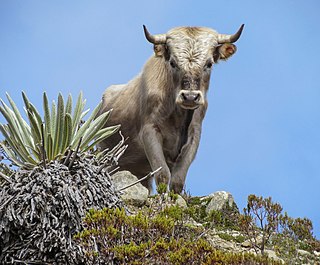
A feral animal or plant is one that lives in the wild but is descended from domesticated individuals. As with an introduced species, the introduction of feral animals or plants to non-native regions may disrupt ecosystems and has, in some cases, contributed to extinction of indigenous species. The removal of feral species is a major focus of island restoration.
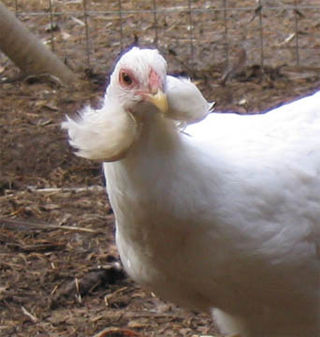
The Araucana is a breed of domestic chicken from Chile. Its name derives from the Araucanía region of Chile where it is believed to have originated. It lays blue-shelled eggs, one of very few breeds that do so.

The red junglefowl is a tropical bird in the family Phasianidae. It ranges across much of Southeast Asia and parts of South Asia. It was formerly known as the bankiva or bankiva fowl. It is the species that gave rise to the chicken ; the grey junglefowl, Sri Lankan junglefowl, and green junglefowl have also contributed genetic material to the gene pool of the chicken.

The Sri Lankan junglefowl, also known as the Ceylon junglefowl or Lafayette's junglefowl, is a member of the Galliformes bird order which is endemic to Sri Lanka, where it is the national bird. It is closely related to the red junglefowl, the wild junglefowl from which the chicken was domesticated. However, a whole-genome molecular study rather show that Sri Lankan junglefowl and grey junglefowl are genetically closer species than the red junglefowl. Sri Lankan junglefowl and red junglefowl diverged about 2.8 million years ago, whereas time of divergence between the Sri Lankan junglefowl and grey junglefowl was 1.8 million years ago.
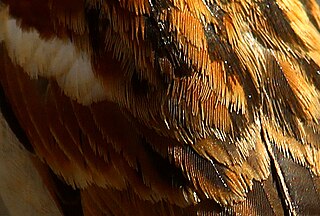
Plumage is a layer of feathers that covers a bird and the pattern, colour, and arrangement of those feathers. The pattern and colours of plumage differ between species and subspecies and may vary with age classes. Within species, there can be different colour morphs. The placement of feathers on a bird is not haphazard but rather emerges in organized, overlapping rows and groups, and these feather tracts are known by standardized names.

The red-capped parrot is a species of broad-tailed parrot native to southwestern Australia. It was described by Heinrich Kuhl in 1820, with no subspecies recognised. It has long been classified in its own genus owing to its distinctive elongated beak, though genetic analysis shows that it lies within the lineage of the Psephotellus parrots and that its closest relative is the mulga parrot. Not easily confused with other parrot species, it has a bright crimson crown, green-yellow cheeks, and a distinctive long bill. The wings, back, and long tail are dark green, and the underparts are purple-blue. The adult female is very similar though sometimes slightly duller than the male; her key distinguishing feature is a white stripe on the wing under-surface. Juveniles are predominantly green.

The gray junglefowl, also known as Sonnerat's junglefowl, is one of the wild ancestors of the domestic chicken together with the red junglefowl and other junglefowls.

The Bekisar, or Ayam Bekisar, is the first-generation hybrid offspring of the green junglefowl and domesticated red junglefowl from Java. The roosters have a glossy blackish-green plumage and are highly prized for their loud clear calls and striking colouration, while the hens are usually dull and infertile.
Gamebird hybrids are the result of crossing species of game birds, including ducks, with each other and with domestic poultry. These hybrid species may sometimes occur naturally in the wild or more commonly through the deliberate or inadvertent intervention of humans.
The Iowa Blue is a breed of chicken that originated near Decorah, Iowa, in the early twentieth century. Despite its name, the breed is not actually blue according to poultry standards. It is an exceedingly rare fowl, and is not recognized for showing by the American Poultry Association. They are a dual-purpose breed laying brown eggs and known to be good foragers.
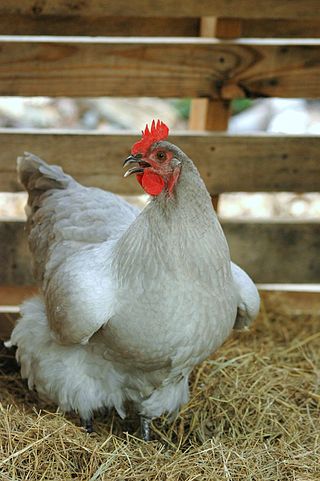
Lavender or self-blue refers to a plumage color pattern in the chicken characterized by a uniform, pale bluish grey color across all feathers. The distinctive color is caused by the action of an autosomal recessive gene, commonly designated as "lav", which reduces the expression of eumelanin and phaeomelanin so that black areas of the plumage appear pale grey instead, and red areas appear a pale buff.

Solid black plumage color refers to a plumage pattern in chickens characterized by a uniform, black color across all feathers. There are chicken breeds where the typical plumage color is black, such as Australorp, Sumatra, White-Faced Black Spanish, Jersey Giant and others. And there are many other breeds having different color varieties, which also have an extended black variety, such as Leghorn, Minorca, Wyandotte, Orpington, Langshan and others.

Gallus giganteus,Jago cock, or Jago Fowl, is a hypothetical species of fowl. It was first described in 1813 by Coenraad Jacob Temminck who named it on the basis of a large foot that he received, having a 5-centimetre (2.0 in) spur. Temminck thought it was a wild bird from southern Sumatra and western Java. Temminck assigned large domesticated species to the binomial Gallus patavinus used by Mathurin Jacques Brisson. It was again described by Leonard Fitzinger in 1878. The birds were described as being large with a comb that extended back in a line along the eye, thick, raised and appearing truncated on the top. The throat was bare and the wattles under the mandibles small. Later authors began to use the name Gallus giganteus for large domesticated species, including from Malabar, which was illustrated in Hardwicke's collection. Temminck believed that Gallus giganteus was one of six wild ancestors of the domestic chicken. Edward Blyth believed that domestic chickens were entirely derived by artificial selection of red junglefowl. Charles Darwin also favoured Blyth's hypothesis.

